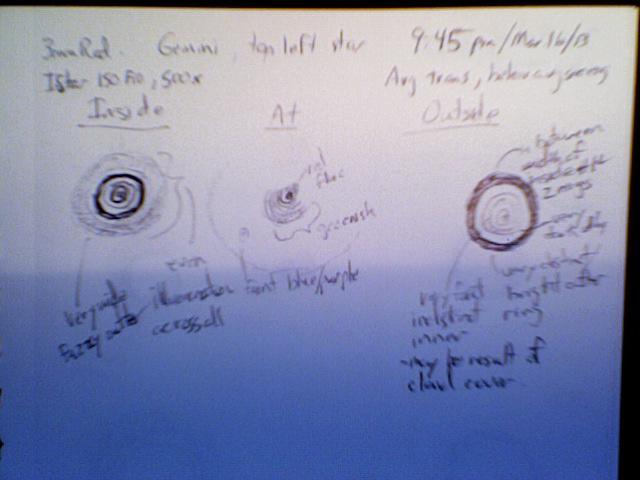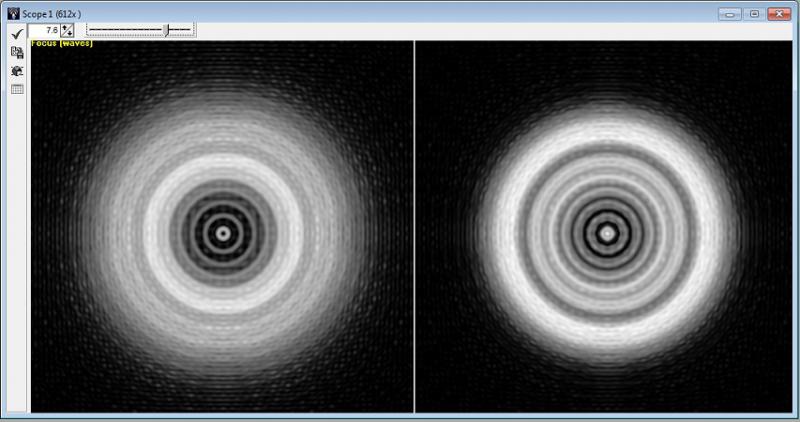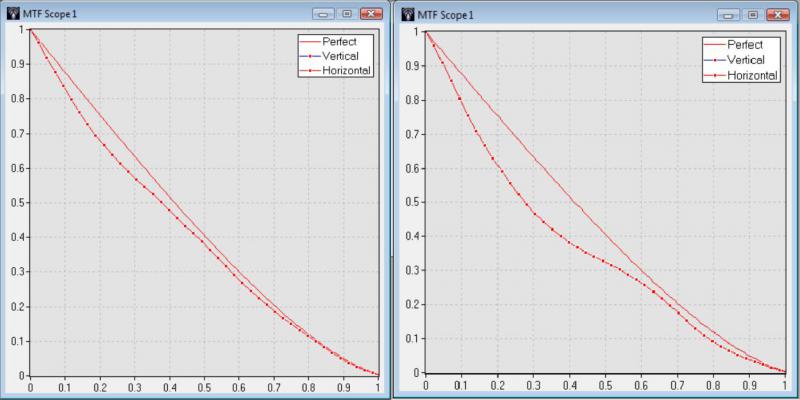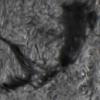While both are forms of spherical abberation, the differnce between LSA and HSA...
The Obstrucion minimizes the presence of HSA duruing ths star test.
But HSA lowers contrast for larger areas of the target than LSA does, and that was your question.
Here is a simulation that shows how LSA differs from HSA.
Eddgie, correct me if I am wrong, but LSA and HSA are not different forms of the same abberation, they ARE spherical aberration expressed in terms of lower and higher orders mathematically. There are not two forms of SA - just one expressed differently.
"Higher-order spherical aberration is merely a consequence of using (close) approximation of the conic surface, instead of the actual surface, in calculating the aberration.
"...does have some significance in certain types of amateur telescopes with typically more strongly curved optical surfaces. In particular, in most apochromatic refractors, as well as Maksutov-Cassegrain (MCT) and Schmidt-Cassegrain (SCT) telescopes."
"When significant, it needs to be minimized by correcting the surfaces in their lower-order approximation so that they better approximate the higher-aberration term surface profile."http://telescope-opt..._aberration.htmSo, while you can discuss HSA separately resulting from corrections to the caustic focus due to adding another highly curved surface, both terms are simply an expression of pure, classical spherical aberration we all know and love. Nothing more, nothing less. HSA does not exist as a separate, weird form of SA. It is SA not accounted for in the lower order approximation of the objective's surface and is induced by changing that approximation by adding another highly curved lens.
The obstruction minimizes the classic "hill" in the balanced wavefront. It obscures that central wavefront deviation thereby eliminating it's contribution to the overall P-V and rms error. You can see that "hill" in the OP image at upper right. By the way, this "hill" is formed by a corrector or meniscus altering the waveform so that the paraxial rays strike the central primary before the 70% zone does. Further correction, or balancing, is achieved by retarding the marginal rays so their reflection lags the 70% zone, the way I visualize it. This is what both the SCT corrector and MCT meniscus attempt to do, and the altered wavefront can be seen in the diffraction pattern (shown in the OP.)
Again, this is probably not required in a long focus achromat, the "lower order approximation" is likely left untouched. So HSA might be present but minimal. You probably wont see the balanced form as shown in the OP.
In my Mak, it was highly likely the secondary baffle vingnetted the deviation from shperical at the marginal wavefront or edge. You can see that in the OP upper right as the wavefront curling back at its edge. By the way, most of this wavefront formation is done at the Schmidt corrector as opposed to the maniscus/primary combo in an MCT. This is what they mean by the corrector has the higher order term ground into it. It's taken care of before the wavefront hits the SCT primary, not so in a MCT OR APO. Both of the latter have some residual.
When HSA is present, I believe you are correct about the contrast loss. Also, aberrator HSA is the balanced form. When you add HSA to the diffraction image, you are also adding LSA at the same time. You're manipulating BHSA, not HSA alone.
I believe I'm seeing over-correction...
...understanding that LSA may be correctable by adjusting the spacing of the elements to bring things closer to neutral. I have the impression that this isn't something that could be done for HSA.
I think over correction, too, without further inspection.
Correcting for LSA in this way might work, balancing for HSA would require a surface refigure. But both are mute points, really, because I would not mess with the separation. Doing so might add color and do nothing for SA....LSA, that is. HSA is likely minimal, already, at that focal length and with that set of achromatic lenses. A long focal ratio achromat with more shallow spherical surfaces will likely not change it's caustic focus much with the introduction of a lens designed to control color - which is probably why it's hard to find a reference for it. Even the image you posted was titled "APO" on Vlad's site.
I could be wrong, though, ask Istar if they balance for HSA. I doubt it, though, because it's prevelent in faster lenses, such as a very fast MCT primary and it's steeply curved meniscus or fast APO objective lenses, probably not so in already long focus achromats. Heck, I'd be interested to know, too, if they do "touch up" their lenses in such a way.



























